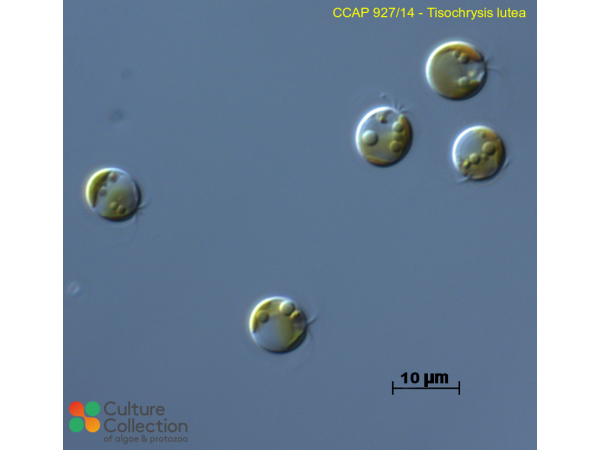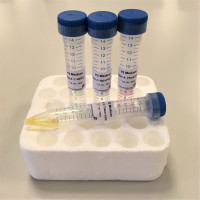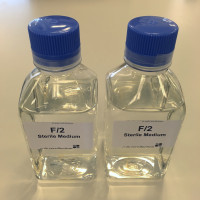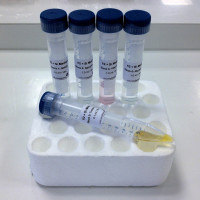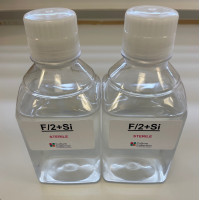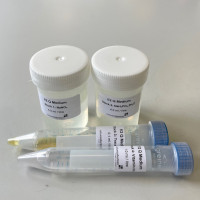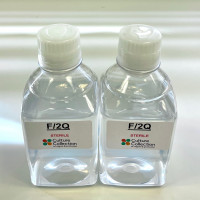References [ 87 ]
Rieley G, Teece MA, Peakman TM, Raven AM, Green KJ, Clarke TP, Murray M, Leftley JW, Campbell CN, Harris RP, Parkes RJ & Maxwell JR (1998) Long-chain alkenes of the haptophytes Isochrysis galbana and Emiliania huxleyi. Lipids 33(6): 617-625.
Sayegh FAQ, Radi N & Montagnes DJS (2007) Do strain differences in microalgae alter their relative quality as a food for the rotifer Brachionus plicatilis? Aquaculture 273: 665-678.
Day JG (1998) Cryo-conservation of microalgae and cyanobacteria. CryoLetters S1: 7-14.
DOI: none
Troedsson C, Ganot P, Bouquet J-M, Aksnes DL & Thompson EM (2007) Endostyle cell recruitment as a frame of reference for development and growth in the Urochordate Oikopleura dioica. The Biological Bulletin 213: 325-334.
DOI: none
Christophersen G, Torkildsen L & van der Meeren T (2006) Effect of increased water recirculation rate on algal supply and post-larval performance of scallop (Pecten maximus) reared in a partial open and continuous feeding system. Aquacultural Engineering 35: 271-282.
Sandaa R-A, Brunvold L, Magnesen T & Bergh Ø (2008) Monitoring the opportunistic bacteria Pseudoalteromonas sp. LT-13 in a great scallop, Pecten maximus hatchery. Aquaculture 276: 14-21.
Kheder RB, Quéré C, Moal J & Robert R (2010) Effect of nutrition on Crassostrea gigas larval development and the evolution of physiological indices. Part B: Effects of temporary food deprivation. Aquaculture 308: 174-182.
Bougaran G, Bernard O & Sciandra A (2010) Modeling continuous cultures of microalgae colimited by nitrogen and phosphorus. Journal of Theoretical Biology 265: 443-454.
Kheder RB, Moal J & Robert R (2010) Impact of temperature on larval development and evolution of physiological indices in Crassostrea gigas. Aquaculture 309: 268-289.
Mairet F, Bernard O, Masci P, Lacour T & Sciandra A (2011) Modelling neutral lipid production by the microalga Isochrysis aff. galbana under nitrogen limitation. Bioresource Technology 102: 142-149.
Rico-Villa B, Bernard I, Robert R & Pouvreau S (2010) A dynamic energy budget (DEB) growth model for Pacific oyster larvae, Crassostrea gigas. Aquaculture 305: 84-94.
Sayegh FAQ & Montagnes DJS (2011) Temperatures shifts induce intraspecific variation in microalgal production and biochemical composition. Bioresource Technology 102: 3007-3013.
Forberg T, Arukwe A & Vadstein O (2011) A protocol and cultivation system for gnotobiotic Atlantic cod larvae (Gadus morhua L.) as a tool to study host microbe interactions. Aquaculture 315: 222-227.
Natrah FMI, Kenmegne MM, Wiyoto W, Sorgeloos P, Bossier P & Defoirdt T (2011) Effects of micro-algae commonly used in aquaculture on acyl-homoserine lactone quorum sensing. Aquaculture 317: 53-57.
Magnesen T & Jacobsen A (2012) Effect of water recirculation on seawater quality and production of scallop (Pecten maximus) larvae. Aquacultural Engineering 47: 1-6.
Marchetti J, Bougaran G, Le Dean L, Mégrier C, Lukomska E, Kaas R, Olivo E, Baron R, Robert R & Cadoret JP (2012) Optimizing conditions for the continuous culture of Isochrysis affinis galbana relevant to commercial hatcheries. Aquaculture 326-329: 106-115.
Jauffrais T, Marcaillou C, Herrenknecht C, Truquet P, Shet V, Nicolau E, Tillmann U & Hess P (2012) Azaspiracid accumulation, detoxification and biotransformation in blue mussels (Mytilus edulis) experimentally fed Azadinium spinosum Toxicon 60: 582-595.
Volkman JK, Jeffrey SW, Nichols PD, Rogers GI & Garland CD (1989) Fatty acid and lipid composition of 10 species of microalgae used in mariculture Journal of Experimental Marine Biology and Ecology 128: 219-240.
DOI: none
Rico-Villa B, Le Coz JR, Mingant C & Robert R (2006) Influence of phytoplankton diet mixtures on microalgae consumption, larval development and settlement of the Pacific oyster Crassostrea gigas (Thunberg) Aquaculture 256: 377-388.
Gonzalez Araya R, Mingant C, Petton B & Robert R (2012) Influence of diet assemblage on Ostrea edulis broodstock conditioning and subsequent larval development. Aquaculture 364-365: 272-280.
Jauffrais T, Contreras A, Herrenknecht C, Truquet P, Sechet V, Tillmann U & Hess P (2012) Effect of Azadinium spinosum on the feeding behaviour and azaspiracid accumulation of Mytilus edulis. Aquatic Toxicology 124-125: 179-187.
Lacour T, Sciandra A, Talec A, Mayzaud P & Bernard O (2012) Neutral lipid and carbohydrate productivities as a response to nitrogen status in Isochrysis sp. (T-iso; Haptophyceae): Starvation versus limitation. Journal of Phycology 48: 647-656.
Lacour T, Sciandra A, Talec A, Mayzaud P & Bernard O (2012) Diel variations of carbohydrates and neutral lipids in nitrogen-sufficient and nitrogen-starved cyclostat cultures of Isochrysis sp. Journal of Phycology 48: 966-975.
Gonzalez-Araya R, Quillien V & Robert R (2013) The effects of eight single microalgal diets on sex-ratio and gonad development throughout European flat oyster (Ostrea edulis L.) conditioning. Aquaculture 400-401: 1-5.
Jauffrais T, Kilcoyne J, Herrenknecht C, Truquet P, Sechet V, Miles CO & Hess P (2013) Dissolved azaspiracids are absorbed and metabolized by blue mussels (Mytilus edulis). Toxicon 65: 81-89.
Pronker AE, Peene F, Donner S, Wijnhoven S, Geijsen P, Bossier P & Nevejan NM (2013) Hatchery cultivation of the common cockle (Cerastoderma edule L.): From conditioning to grow-out. Aquaculture Research -: 1-11.
van Bergeijk SA, Herandez Javier L, Manchado M & Canavate JP (2013) Uptake of iodide in the marine haptophyte Isochrysis sp. (T.ISO) driven by iodide oxidation. Journal of Phycology 49: 640-647.
Bendif EM, Probert I, Schroeder DC & de Vargas C (2013) On the description of Tisochrysis lutea gen. nov. sp. nov. and Isochrysis nuda sp. nov. in the Isochrysidales, and the transfer of Dicrateria to the Prymnesiales (Haptophyta) Journal of Applied Phycology 25: 1763-1776.
Garnier M, Carrier G, Rogniaux H, Nicolau E, Bougaran G, Saint-Jean B & Cadoret JP (2014) Comparative proteomics reveals proteins impacted by nitrogen deprivation in wild-type and high lipid-accumulating mutant strains of Tisochrysis lutea. Journal of Proteomics 105: 107-120.
Marti-Solans J, Ferrandez-Roldan A, Godoy-Marin H, Badia-Ramentol J, Torres-Aguila NP, Rodriguez-Mari A, Bouquet JM, Chourrout D, Thompson EM, Albalat R & Canestro C (2014) Oikopleura dioica culturing made easy: A low-cost facility for an emerging animal model in EvoDevo. Genesis 53: 183-193.
Carrier G, Garnier M, Le Cunff L, Bougaran G, Probert I, De Vargas C, Corre E, Cadoret JP & Saint-Jean B (2014) Comparative transcriptome of wild type and selected strains of the microalgae Tisochrysis lutea provides insights into the genetic basis, lipid metabolism and the life cycle. PLoS ONE 9(1): e86889.
Baroukh C, Muñoz-Tamayo R, Steyer J & Bernard O (2014) DRUM: A new framework for metabolic modeling under non-balanced growth. Application to the carbon metabolism of unicellular microalgae. PLoS ONE 9(8): e104499.
Pernet F, Tamayo D & Petton B (2015) Influence of low temperatures on the survival of the Pacific oyster (Crassostrea gigas) infected with ostreid herpes virus type 1. Aquaculture 445: 57-62.
Da Costa F, Petton B, Mingant C, Bougaran G, Rouxel C, Quéré C, Wikfors GH, Soudant P & Robert R (2015) Influence of one selected Tisochrysis lutea strain rich in lipids on Crassostrea gigas larval development and biochemical composition. Aquaculture Nutrition 22: 813-836.
Charrier A, Bérard J, Bougaran G, Carrier G, Lukomska E, Schreiber N, Fournier F, Charrier A, Rouxel C, Garnier M, Cardoret J & Saint-Jean B (2015) High-affinity nitrate/nitrite transporter genes (Nrt2) in Tisochrysis lutea: Identification and expression analyses reveal some interesting specificities of Haptophyta microalgae. Physiologia Plantarum 154: 572-590.
Slocombe SP, Zhang QY, Ross M, Anderson A, Thomas NJ, Lapresa A, Rad Menéndez C, Campbell CN, Black KD, Stanley MS & Day JG (2015) Unlocking nature's treasure-chest: Screening for oleaginous algae. Scientific Reports 5: 09844.
Tüccar G, Güngör C, Uludamar E & Aydin K (2015) The potential of microalgal biodiesel in Turkey Energy Sources, Part B 10: 397-403.
Réveillon D, Séchet V, Hess P & Amzil Z (2015) Systematic detection of BMAA (β-N-methylamino-L-alanine) and DAB (2,4-diaminobutyric acid) in mollusks collected in shellfish production areas along the French coasts. Toxicon 110: 35-46.
Bouquet JM, Spriet E, Troedsson C, Ottera H, Chourrout D & Thompson EM (2009) Culture optimization for the emergent zooplanktonic model organism Oikopleura dioica. Journal of Plankton Research 31: 359-370.
Troedsson C, Bouquet JM, Skinnes R, Acuna JL, Zech K, Frischer ME & Thompson EM (2009) Regulation of filter-feeding house components in response to varying food regimes in the appendicularian, Oikopleura dioica. Journal of Plankton Research 31: 1453-1463.
Olsen BR, Dahlgren K, Schander C, Bamstedt U, Rapp HT & Troedsson C (2012) PCR-DHPLC assay for the identification of predator-prey interactions. Journal of Plankton Research 34: 277-285.
Sussarellu R, Suquet M, Thomas Y, Lambert C, Fabioux C, Pernet MEJ, Le Goic N, Guillien V, Mingant C, Epelboin Y, Corporeau C, Guyomarch J, Robbens J, Paul-Pont I, Soudant P & Huvet A (2016) Oyster reproduction is affected by exposure to polystyrene microplastics. PNAS 113: 2430-2435.
Lama S, Muylaert K, Karki TB, Foubert I, Henderson RK & Vandamme D (2016) Flocculation properties of several microalgae and a cyanobacterium species during ferric chloride, chitosan and alkaline flocculation. Bioresource Technology 220: 464-470.
Asmani K, Petton B, Le Grand J, Mounier J, Robert R & Nicolas J (2016) Establishment of microbiota in larval culture of a Pacific oyster, Crassostrea gigas. Aquaculture 464: 434-444.
Balduyck L, Bijttebier S, Bruneel C, Jacobs G, Voorspoels S, Van Durme J, Muylaert K & Foubert I (2016) Lipolysis in T-Isochrysis lutea during wet storage at different temperatures. Algal Research 18: 281-287.
Garnier M, Bougaran G, Pavlovic M, Berard JB, Carrier G, Charrier A, Le Grand F, Lukomska E, Rouxel C, Schreiber N, Cadoret, JP, Rogniaux H & Saint-Jean B (2016) Use of a lipid rich strain reveals mechanisms of nitrogen limitation and carbon partitioning in the haptophyte Tisochrysis lutea Algal Research 20: 229-248.
Bailey A, Thor P, Browman HI, Fields DM, Runge J, Vermont A, Bjelland R, Thompson C, Shema S, Durif CMF & Hop H (2017) Early life stages of the Arctic copepod Calanus glacialis are unnaffected by increased seawater pCO2. ICES Journal of Marine Science 74: 996-1004.
Serive B, Nicolau E, Bérard JB, Kaas R, Pasquet V, Picot L & Cadoret JP (2017) Community analysis of pigment patterns from 37 microalgae strains reveals new carotenoids and porphyrins characteristic of distinct strains and taxonomic groups. PLoS ONE : e0171872.
Po BHK, Ho KL, Lam MHW, Giesy JP & Chiu JMY (2017) Uptake and biotransformation of 2,2′,4,4′-tetrabromodiphenyl ether (BDE-47) in four marine microalgae species. Scientific Reports 7: 44263.
Long M, Paul-Pont I, Hégaret H, Moriceau B, Lambert C, Huvet A & Soudant P (2017) Interactions between polystyrene microplastics and marine phytoplankton lead to species-specific hetero-aggregation. Environmental Pollution 228: 454-463.
Carrier G, Baroukh C, Rouxel C, Duboscq-Bidot L, Schreiber N & Bougaran G (2018) Draft genomes and phenotypic characterization of Tisochrysis lutea strains. Toward the production of domesticated strains with high added value. Algal Research 29: 1-11.
da Costa F, Le Grand F, Quére C, Bougaran G, Cadoret JP, Robert R & Soudant P (2017) Effects of growth phase and nitrogen limitation on biochemical composition of two strains of Tisochrysis lutea. Algal Research 27: 177-189.
Balduyck L, Stock T, Bijttebier S, Bruneel C, Jacobs G, Voorspoels S, Muylaert K & Foubert I (2017) Integrity of the microalgal cell lays a major role in the lipolytic stability during wet storage. Algal Research 25: 516-524.
Bonnefond H, Grimaud G, Rumin J, Bougaran G, Talec A, Gachelin M, Boutoute M, Pruvost E, Bernard O & Sciandra A (2017) Continuous selection pressure to improve temperature acclimation of Tisochrysis lutea PLoS ONE 12(9): e0183547.
Robert R, Vignier J & Petton B (2017) Influence of feeding regime and temperature on development and settlement of oyster Ostrea edulis (Linnaeus, 1758) larvae Aquaculture Research 48: 4756-4773.
Bailey A, De Wit P, Thor P, Browman HI, Bjelland R, Shema S, Fields DM, Runge JA, Thompson C & Top H (2017) Regulation of gene expression is associated with tolerance of the Arctic copepod Calanus glacialis to CO2-acidified sea water Ecology and Evolution 7: 7145-7160.
Ridley CJA, Parker BM, Norman L, Schlarb-Ridley B, Dennis R, Jamieson AE, Clark D, Skill SC, Smith AG & Davey MP (2018) Growth of microalgae using nitrate-rich brine wash from the water industry Algal Research 33: 91-98.
Pousse E, Flye-Sainte-Marie J, Alunno-Bruscia M, Hégaret H & Jean F (2018) Sources of paralytic shellfish toxin accumulation variability in the Pacific oyster Crassostrea gigas Toxicon 144: 14-22.
Delisle L, Petton B, Burguin JF, Morga B, Corporeau C & Pernet F (2018) Temperature modulate disease susceptibility of the Pacific oyster Crassostrea gigas and virulence of the Ostreid herpesvirus type 1 Fish & Shellfish Immunology 80: 71-79.
Dupraz V, Stachowski-Haberkorn S, Ménard D, Limon G, Akcha F, Budzinski H & Cedergreen N (2018) Combined effects of antifouling biocides on the growth of three marine microalgal species Chemosphere 209: 801-814.
Thiriet-Rupert S, Carrier G, Trottier C, Eveillard D, Schoefs B, Bougaran G, Cadoret JP, Chénais B & Saint-Jean B (2018) Identification of transcription factors involved in the phenotype of a domesticated oleaginous microalgae strain of Tisochrysis lutea Algal Research 30: 59-72.
González-Araya R & Robert R (2018) Larval development and fatty acid composition of Ostrea edulis (L.) fed four different single diets from conditioning to pre‐settlement Aquaculture Research 49: 1768-1781.
Méndez-Leyva AB, Guo J, Mudd EA, Wong J, Schwartz JM & Day A (2019) The chloroplast genome of the marine microalga Tisochrysis lutea Mitochondrial DNA Part B Resources 4: 253-255.
de Lorgeril J et al. (2018) Immune-suppression by OsHV-1 viral infection causes fatal bacteraemia in Pacific oysters Nature Communications 9: 4215.
Kapsenberg L, Miglioli A, Bitter MC, Tambutté E, Dumollard R & Gattuso JP (2018) Ocean pH fluctuations affect mussel larvae at key developmental transitions Proceedings of the Royal Society of London Series B 285: 20182381.
Dupraz V, Stachowski-Haberkorn S, Wicquart J, Tapie N, Budzinski H & Akcha F (2019) Demonstrating the need for chemical exposure characterisation in a microplate test system: toxicity screening of sixteen pesticides on two marine microalgae Chemosphere 221: 278-291.
Fuhrmann M, Richard G, Quéré C, Petton B & Pernet F (2019) Low pH reduced survival of the oyster Crassostrea gigas exposed to the Ostreid herpesvirus 1 by altering the metabolic response of the host Aquaculture 503: 167-174.
Castrec J, Hégaret H, Alunno-Bruscia M, Picard M, Soudant P, Petton B, Boulais M, Suquet M, Quéau I, Ratiskol D, Foulon V, Le Goic N & Fabioux C (2019) The dinoflagellate Alexandrium minutum affects development of the oyster Crassostrea gigas, through parental or direct exposure Environmental Pollution 246: 827-836.
Balduyck L, Dejonghe C, Goos P, Jooken E, Muylaert K & Foubert I (2019) Inhibition of lipolytic reactions during wet storage of T-Isochrysis lutea biomass by heat treatment Algal Research 38: 101388.
Pousse E et al. (2019) Modelling paralytic shellfish toxins (PST) accumulation in Crassostrea gigas by using Dynamic Energy Budgets (DEB) Journal of Sea Research 143: 152-164.
Nef C, Jung S, Mairet F, Kaas R, Grizeau D & Garnier M (2019) How haptophytes microalgae mitigate vitamin B12 limitation Scientific Reports 9: 8417.
Sun Z, Wang X & Liu J (2019) Screening of Isochrysis strains for simultaneous production of docosahexaenoic acid and fucoxanthin Algal Research 41: 101545.
Iglesias MJ, Soengas R, Probert I, Guilloud E, Gourvil P, Mehiri M, López Y, Cepas V, Gutiérrez-del-Río I, Redondo-Blanco S, Villar CJ, Lombó F, Soto S & López Ortiz F (2019) NMR characterization and evaluation of antibacterial and antiobiofilm activity of organic extracts from stationary phase batch cultures of five marine microalgae (Dunaliella sp., D. salina, Chaetoceros calcitrans, C. gracilis and Tisochrysis lutea) Phytochemistry 164: 192-205.
Pavaux A, Rostan J, Guidi-Guilvard L, Marro S, Ternon E, Olivier PT, Lemée R & Gasparini S (2019) Effects of the toxic dinoflagellate Ostreopsis cf. ovata on survival, feeding and reproduction of a phytal harpacticoid copepod Journal of Experimental Marine Biology and Ecology 516: 103-113.
Dupraz V, Ménard D, Akcha F, Budzinski H & Stachowski-Haberkorn S (2019) Toxicity of binary mixtures of pesticides to the marine microalgae Tisochrysis lutea and Skeletonema marinoi: Substance interactions and physiological impacts Aquatic Toxicology 211: 148-162.
Huang B, Marchand J, Thiriet-Rupert S, Carrier G, Saint-Jean B, Lukomska E, Moreau B, Morant-Manceau A, Bougaran G & mimouni V (2019) Betaine lipid and neutral lipid production under nitrogen or phosphorus limitation in the marine microalga Tisochrysis lutea (Haptophyta) Algal Research 40: 101506.
Gallego R, Tardiff C, Parreira C, Guerra T, Alves MJ, Ibánez E & Herrero M (2020) Simultaneous extraction and purification of fucoxanthin from Tisochrysis lutea microalgae using compressed fluids Journal of Separation Science -: -.
Diéguez AL, Balboa S, Magnesen T, Jacobsen A, Lema A & Romalde JL (2019) Comparative study of the culturable microbiota present in two different rearing systems, flow‐through system (FTS) and recirculation system (RAS), in a great scallop hatchery Aquaculture Research 51: 542-556.
Goncalves de Oliveira-Junior R, Grougnet R, Bodet PE, Bonnet A, Nicolau E, Jebali A, Rumin J & Picot L (2020) Updated pigment composition of Tisochrysis lutea and purification of fucoxanthin using centrifugal partition chromatography coupled to flash chromatography for the chemosensitization of melanoma cells Algal Research 51: 102035.
Pernet F, Lugué K & Petton B (2021) Competition for food reduces disease susceptibility in a marine invertebrate Ecosphere 12(4): e03435.
Huesemann M, Edmundson S, Gao S, Negi S, Dale T, Gutknecht A, Daligault HE, Carr CK, Freeman J, Kern T, Starkenburg SR, Gleasner CD, Louie W, Kruk R & McGuire S (2023) DISCOVR strain pipeline screening - Part I: Maximum specific growth rate as a function of temperature and salinity for 38 candidate microalgae for biofuels production Algal Research -: 102996.
Pajot A, Chollet S, Nicolau E & Marchal L (2023) Improving the extraction and the purification of fucoxanthin from Tisochrysis lutea using centrifugal partition chromatography Algal Research 74: 103174.
Loor A, Bossier P, Wang D, De Bels L, Van den Broeck W, Nevejan N & Declercq A (2023) Effect of continuous dietary administration of the Saccharomyces cerevisiae yeast, Δmnn9, on Pacific oyster ((Crassostrea gigas) juveniles: Immunological and histopathological findings after Vibrio coralliilyticus challenge Aquaculture 574: 739644.
He Z, Wang J & Li Y (2024) Recent Advances in Microalgae-driven Carbon Capture, Utilization, and Storage: Strain Engineering through Adaptive Laboratory Evolution and Microbiome Optimization Green Carbon -: -.
Georgoulis I, Papadopoulos DK, Lattos A, Michaelidis B, Feidantsis K & Giantsis IA (2024) Increased seawater temperature triggers thermal, oxidative and metabolic response of Ostrea edulis, leading to anaerobiosis Comparative Biochemistry and Physiology 271: 110943.
Roux P, García-Corona JL, Ragueneau S, Schapira M, Siano R, Pernet F, Queau I, Malestroit P, Tallec K & Fleury E (2024) Ecophysiological response of the cupped oyster Crassostrea gigas exposed to the green dinoflagellate Lepidodinium chlorophorum Aquaculture 584: 740644.
Marchese D, Rosengart A, Barbera E & Sforza E (2025) Exploring a bicarbonate-based carbon capture approach applicability to industrially relevant marine microalgae. Chemical Engineering Transactions 117: 259-264.

